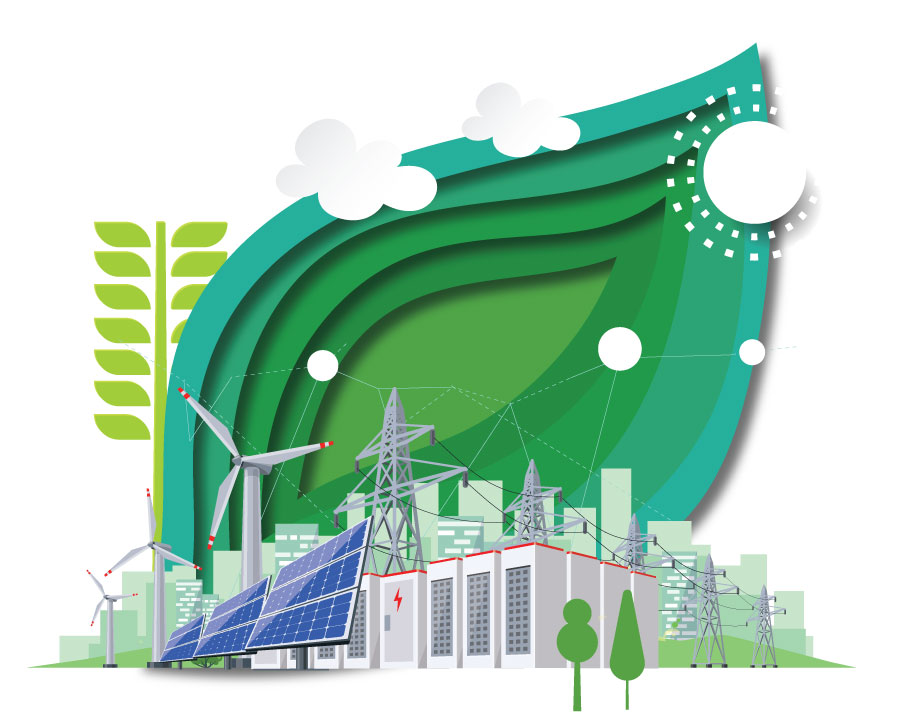Energy Blog: Are Gas Utilities About to Enter a Death Spiral?
Energy Blog: Are Gas Utilities About to Enter a Death Spiral?


Some fear that as customers adopt electric alternatives, gas companies could face an inescapable crisis.
I was a commissioner for our local electric utility during the raucous years of 2008 to 2013, which spanned a global financial collapse, the shale revolution, plummeting wind and solar prices, and the rise of the smart grid. Our municipal utility had more than 1,000 employees, annual revenues exceeding $1 billion, and peak load of about 3 GW. Though the utility served one of the fastest-growing cities in the United States and was on solid financial footing, we perpetually worried about the utility death spiral.
The utility death spiral is a phenomenon that spelled doom for electric providers coast-to-coast. The idea is that as rooftop solar panel prices dropped, customers would leave the utility to use their cleaner, on-site power production instead. That meant the utility’s extensive fixed costs for power plants, equipment, and power lines would be spread across a smaller user base, driving costs up for the remaining customers, making them more likely to flee the utility, driving costs up again, and so forth—presumably accelerating the downward slide of the utility’s revenues until all that was left were the few homes that didn’t have solar panels because their roofs could not accommodate them or because their tree shading made it impractical.
This was a persistent worry and level (or decreasing) electricity consumption nationally in the late 2000s and early 2010s affirmed that the fears were not unfounded.
More like this: More on Energy: Climate of Optimism
But it never came to be. Quite the opposite, actually. The power sector has become the central fulcrum of decarbonizing the economy and now is projected to double or triple in the coming decades as drivers replace gasoline engines with electric cars and other electrical appliances gain market share.
The turnaround is stunning and raises a new risk: Are gas utilities about to enter a death spiral?
After all, as customers replace gas furnaces with electric heat pumps and factories replace fuels with electrons for their industrial heat and processes, the need for gas will drop. But the pipelines, storage caverns, and compressor stations will still be needed, and those costs will be spread across a smaller customer base, driving up costs for gas, which makes electricity a more appealing alternative, and so on and so forth.
The argument for the decline of gas utilities is inescapable. But is it accurate?
Natural gas consumption has been rising. So how do we reconcile the growth in gas consumption, the growth in electricity consumption, and the need for decarbonization? It’s not clear how this will all unfold, but I wouldn’t be surprised if gas utilities see their value grow as our needs change. They key is for gas utilities to redefine their role in the energy system.
Read further: From the Energy Blog: Mechanical Engineers to the Rescue
Looking backwards, this kind of concern about a death spiral often happens. And happens to be wrong. The rise of email in the 1990s was supposed to make the use of paper unnecessary, but paper consumption has soared. The rise of videoconferencing was supposed to create a death spiral for aviation, but airline miles continue to increase. The rise of digital books was supposed to make printed books irrelevant, yet printed book sales are still growing.
Yet there are real declines. Coal use has dropped in places like the United States and the United Kingdom. And buggy whips and typewriters have disappeared.
What does this mean for the gas utility?
In my interpretation this means that the gas utility is indeed at risk of enduring a death spiral unless it finds a way to be part of the energy mix in a way that is compatible with our requirements to get to net-zero emissions as quickly as possible. Thankfully, there are many low-carbon fuels—biomethane, fossil methane with carbon capture, hydrogen or hydrogen carriers such as ammonia, methanol, or formic acid—and therefore ways gas utilities can be part of the future.
Also of interest: More on This Topic: Hydrogen Straight from the Earth
Not only that, but multiple independent analyses have concluded that keeping gas in the mix helps the economy get to net-zero emissions in a cheaper, faster, and more equitable path. DNV’s analysis for Europe concluded that gaseous fuels are about a third of the energy mix in a decarbonized future. A prominent study in a top scientific journal concluded that natural gas in the power sector is a critical piece of a net-zero future. And my own team’s work at the University of Texas has concluded that keeping fuels such as methane, hydrogen and ammonia in the mix not only could get CO2-intensive Texas to net-zero by 2050, but that keeping them in the mix is cheaper than excluding fuels.
Not only are there many low-carbon fuels available, but they provide high-value services that are hard to meet with electrons, such as winter heating, backup when the grid fails, and serving loads that are hard or expensive to electrify such as marine shipping, aviation, and industrial process heat. Most importantly, there are tens of trillions of dollars of sunk capital costs globally in gas infrastructure, and it would be cheaper and faster for us to leverage existing assets and capabilities—perhaps to move new types of molecules—than to replace them entirely. It might be that the volumes of gas moved and sold will be smaller, but the value will be higher.
All in all, it seems we’re at a turning point, and whether the world’s gas utilities turn down or up remains to be seen. But I’m betting on gas utilities continuing to serve a critical role.
Michael E. Webber is the Josey Centennial Professor of Energy Resources at the University of Texas in Austin.
The utility death spiral is a phenomenon that spelled doom for electric providers coast-to-coast. The idea is that as rooftop solar panel prices dropped, customers would leave the utility to use their cleaner, on-site power production instead. That meant the utility’s extensive fixed costs for power plants, equipment, and power lines would be spread across a smaller user base, driving costs up for the remaining customers, making them more likely to flee the utility, driving costs up again, and so forth—presumably accelerating the downward slide of the utility’s revenues until all that was left were the few homes that didn’t have solar panels because their roofs could not accommodate them or because their tree shading made it impractical.
This was a persistent worry and level (or decreasing) electricity consumption nationally in the late 2000s and early 2010s affirmed that the fears were not unfounded.
More like this: More on Energy: Climate of Optimism
But it never came to be. Quite the opposite, actually. The power sector has become the central fulcrum of decarbonizing the economy and now is projected to double or triple in the coming decades as drivers replace gasoline engines with electric cars and other electrical appliances gain market share.
The turnaround is stunning and raises a new risk: Are gas utilities about to enter a death spiral?
After all, as customers replace gas furnaces with electric heat pumps and factories replace fuels with electrons for their industrial heat and processes, the need for gas will drop. But the pipelines, storage caverns, and compressor stations will still be needed, and those costs will be spread across a smaller customer base, driving up costs for gas, which makes electricity a more appealing alternative, and so on and so forth.
The argument for the decline of gas utilities is inescapable. But is it accurate?
Natural gas consumption has been rising. So how do we reconcile the growth in gas consumption, the growth in electricity consumption, and the need for decarbonization? It’s not clear how this will all unfold, but I wouldn’t be surprised if gas utilities see their value grow as our needs change. They key is for gas utilities to redefine their role in the energy system.
Read further: From the Energy Blog: Mechanical Engineers to the Rescue
Looking backwards, this kind of concern about a death spiral often happens. And happens to be wrong. The rise of email in the 1990s was supposed to make the use of paper unnecessary, but paper consumption has soared. The rise of videoconferencing was supposed to create a death spiral for aviation, but airline miles continue to increase. The rise of digital books was supposed to make printed books irrelevant, yet printed book sales are still growing.
Yet there are real declines. Coal use has dropped in places like the United States and the United Kingdom. And buggy whips and typewriters have disappeared.
What does this mean for the gas utility?
In my interpretation this means that the gas utility is indeed at risk of enduring a death spiral unless it finds a way to be part of the energy mix in a way that is compatible with our requirements to get to net-zero emissions as quickly as possible. Thankfully, there are many low-carbon fuels—biomethane, fossil methane with carbon capture, hydrogen or hydrogen carriers such as ammonia, methanol, or formic acid—and therefore ways gas utilities can be part of the future.
Also of interest: More on This Topic: Hydrogen Straight from the Earth
Not only that, but multiple independent analyses have concluded that keeping gas in the mix helps the economy get to net-zero emissions in a cheaper, faster, and more equitable path. DNV’s analysis for Europe concluded that gaseous fuels are about a third of the energy mix in a decarbonized future. A prominent study in a top scientific journal concluded that natural gas in the power sector is a critical piece of a net-zero future. And my own team’s work at the University of Texas has concluded that keeping fuels such as methane, hydrogen and ammonia in the mix not only could get CO2-intensive Texas to net-zero by 2050, but that keeping them in the mix is cheaper than excluding fuels.
Not only are there many low-carbon fuels available, but they provide high-value services that are hard to meet with electrons, such as winter heating, backup when the grid fails, and serving loads that are hard or expensive to electrify such as marine shipping, aviation, and industrial process heat. Most importantly, there are tens of trillions of dollars of sunk capital costs globally in gas infrastructure, and it would be cheaper and faster for us to leverage existing assets and capabilities—perhaps to move new types of molecules—than to replace them entirely. It might be that the volumes of gas moved and sold will be smaller, but the value will be higher.
All in all, it seems we’re at a turning point, and whether the world’s gas utilities turn down or up remains to be seen. But I’m betting on gas utilities continuing to serve a critical role.
Michael E. Webber is the Josey Centennial Professor of Energy Resources at the University of Texas in Austin.





